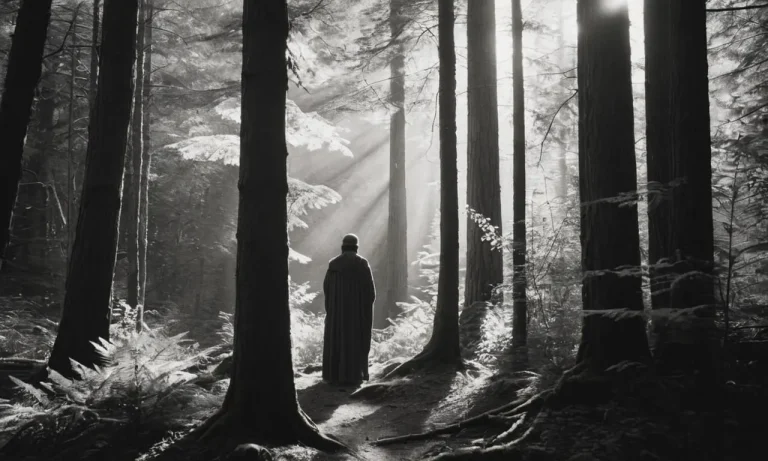Trees have captivated humans for millennia. Their majestic size, longevity, and annual cycles of decay and rebirth have inspired awe, wonder, and spiritual connections across cultures.
If you’re short on time, here’s a quick answer to what trees spiritually represent: Trees are ancient symbols of life, wisdom, transformation, strength, protection, stability, and rebirth in circles. Their rings, roots, branches, leaves, blossoms, seeds, and fruits relate to spiritual concepts of growth, change, grounding, and interconnectedness in nature.
In this comprehensive guide, we’ll explore the profound spiritual symbolism and meaning behind trees and components like rings, roots, wood, leaves, blossoms, seeds, and fruits. We’ll see how these aspects relate to spiritual ideas of grounding, stability, interconnectedness, cycles, seasons, life passages, growth, change, and rebirth.
And we’ll uncover why trees are central symbols and sacred beings in faiths and cultures worldwide as bridges between heaven and earth, the mortal and divine.
Tree Rings and the Concept of Time
Tree rings provide a fascinating window into the concept of time. As trees grow, they produce new layers of woody tissue each year under the bark. These layers appear as rings in a cross section of the tree.
The rings provide a record of the tree’s life and allow us to literally count the passing years in a tangible way.
The varying thickness of each ring documents the climate and growing conditions during each year of the tree’s life. Thin rings indicate years with less than ideal conditions like droughts or severe winters. Thick rings show years of abundant moisture and sunlight.
When conditions improve, more cell growth occurs and wider rings are added.
Dendrochronology, the scientific method of dating events and environmental change by studying tree ring growth patterns, lets us extend this concept back thousands of years in some cases. Overlapping lifespans of living and dead trees create an unbroken chronology exceeding ten thousand years for certain ancient bristlecone pine trees.
As we study the tree ring record, we marvel at the persistence of trees through time. Even when facing adversity, trees continue living and growing. The tree rings remind us of the cycles of hardship and prosperity in our own lives. Trees teach us patience to persevere.
Just as a tree trustingly puts down roots each spring, we can ground ourselves despite temporary setbacks, confident that better times will come.
The concentric rings circulating outwards from the center of a tree section further evoke ripples spreading across a pond over time. This represents our influence, however small, contributing to the larger flow of life.
The continuity of tree rings and generations of trees interlinked across centuries symbolize the unity of past, present and future.
So as we notice the tree rings, we should feel gratitude and wonder for all the tree has weathered and recorded. Tree rings truly represent a tangible imprint of time itself. They remind us to live fully in each season and moment before it too becomes another ring on the tree of life.
Roots, Grounding, and Connectedness
Tree roots have deep symbolic meaning when it comes to spirituality. Their roots grow down into the earth, grounding the tree and allowing it to stand tall and reach to the heavens. This reflects the idea that we must be grounded and connected in order to grow.
Stability and Support
A tree’s extensive root system provides stability and support, keeping it upright and preventing it from toppling over. This parallels the way in which spiritual roots provide us with stability in life’s storms.
When we have strong bonds to community, faith, and purpose, we are less likely to fall over when difficulties arise.
Trees also often grow together in groves and forests, their roots intertwining and holding each other up. This reflects the spiritual wisdom that we must support and strengthen one another on our journeys.
Access to Sustenance
Roots access water and nutrients from the soil that the rest of the tree needs to live and thrive. This symbolizes the way in which grounding ourselves in spiritual rituals and practices allows us to access the sustenance we need for growth.
For example, practices like meditation, prayer, chanting, or worship can help us feel centered and tap into our inner wisdom. Community participation, volunteer work, or activism can also provide nourishment.
Interconnection and Oneness
Unlike animals, which can move about independently, trees are bound to a single place by their roots. This reflects the spiritual principle of interconnection – we are all integral parts of the larger fabric of life on this planet.
Their roots intermingle below the surface, reminding us that at a deeper level, we are all connected. Modern science reflects this wisdom, having revealed that all plants are connected by an underground network of fungus roots that communicates nutrients and information across vast distances.
By sinking our own roots into spiritual soil, we tap into this vast underground web of unity and gain a wider perspective of our place within the Oneness of all life.
Descending Before Ascending
Trees teach us that in order to touch the sky, we must first be willing to sink down into the earth. By rooting ourselves firmly in the ground, we gain the foundation we need to reach upward.
This reflects the spiritual wisdom that first we must ground, center, and anchor ourselves before we can elevate our consciousness. We must meet our basic needs and cultivate inner stillness before transcendence can occur.
Roots humble us, pulling us down to earth so that we stay connected even as we aspire to lofty heights. They keep us nourished in body, mind and spirit.
Branches Stretching to Heaven
Trees have long been revered by many cultures and spiritual traditions for their connection between the heavens and earth. The branching patterns seem to mirror our own nervous systems, acting as conduits between the material and ethereal realms.
As Khalil Gibran poetically stated, “Trees are poems the earth writes upon the sky. “
The crown of a mature tree, with its intricate web of branches and leaves reaching skyward, has an otherworldly beauty. It’s easy to imagine these outstretched limbs as psychic antennae, channels for divine energy and insight.
This is likely why the archetype of the Tree of Life, or World Tree, is so prevalent.
In many folk tales and origin myths, a cosmic tree connects the underworld, earth, and the heavens. It transports prayers and blessings between realms. The Norse had Yggdrasil, the ancient Maya had the Ceiba, and Buddhism holds the Bodhi tree as sacred.
Modern physics tells us that trees connect atmospheres through carbon cycles and energy flows. Perhaps ancient peoples sensed this significance in a more mystical way.
Carrying Messages Through the Elements
A mature tree can have over 48 million leaves, and the total surface area of foliage from a single tree can cover a fifth of an acre. This broad spread interacts with the elements in several ways:
- Leaves exchange gases, moisture and micronutrients with the atmosphere.
- Roots tunnel through the soil, accessing nutrients and minerals.
- The whole vascular system transports water and dissolved compounds.
In essence, trees become like giant antennae, sending and receiving electromagnetic signals by interacting with the sun, air, water, and earth. Is it any wonder that shamans, poets, philosophers, and spiritual teachers throughout the ages have looked to trees for guidance?
Their capacity to channel energy and information seems limitless.
| Species | Height (ft) | Age (years) |
| Giant Sequoia | 311 | 3,200 |
| Coast Redwood | 379 | 2,200 |
| Great Basin Bristlecone Pine | 114 | 4,900 |
Trees like sequoias and bristlecone pines demonstrate the vast potential for tree lifespans, far surpassing human generations. Who knows what knowledge the most ancient specimens have accumulated, observing eras pass as their branches continue receiving cosmic input?
Leaves and Seasonal Cycles
Trees go through amazing transformations throughout the seasons. Their leaves change color, fall to the ground, regrow – all according to nature’s cycles. The patterns of leaves and seasons can impart spiritual lessons about life, death, renewal, and our connection to the environment.
Autumn Leaves and Letting Go
In autumn, deciduous trees prepare for winter by absorbing nutrients from leaves before shedding them. The vivid oranges, reds and yellows that emerge as chlorophyll breaks down have long inspired awe and admiration.
The falling leaves can represent the bittersweet but necessary process of letting go, of surrendering what is no longer serving our highest good. Just as trees release leaves to conserve energy, we too may need to clear space in our lives – end relationships, leave jobs or homes, pursue simplification – to make room for new growth.
The Beauty of Impermanence
The bursting fall foliage soon fades and scatters. This illustrates the Buddhist teaching of impermanence – that all things in our conditional world are transient. Autumn leaves teach us to appreciate beauty in the present moment, not cling onto what inevitably passes.
Impermanence and change are the only constants. Each leaf that falls fertilizes the soil for future flowers and fruits.
Watching leaves decay and return nutrients to the earth, we gain perspective that decay and death are natural parts of life’s cycle. As we learn acceptance of life’s fleeting joys and sorrows, we suffer less. “That which wilts need not be ugly,” says Thich Nhat Hanh.
Composting fallen leaves, we see destruction and creation are two sides of one coin.
The Hope of Spring
After leaves fall and winter strips landscapes bare, the miracle of spring growth reminds us of nature’s resilience. The unfurling buds and fresh green shoots speak to the hope, renewal and new beginnings that emerge after life’s darkest seasons.
Ancient pagans celebrated spring equinox as symbolic of overcoming death’s grip after winter.
Like deciduous trees that regenerate leaves, we too have innate capacities for healing and starting anew. Patiently nurturing our tender new growth allows a fuller flourishing despite – or because of – needed periods of shedding, surrender, death and rebirth.
The eternal cycles of trees instill hope that each ending enables another new beginning.
So as seasons change, notice messages from Mother Nature about impermanence, death, rebirth and our interconnection with her cycles. Trees deepen our wisdom, resilience and reverence for this earth we all call home.
Seeds, Fruits, and Rebirth
Trees produce seeds and fruits as part of their natural life cycle, enabling them to reproduce and create new life. Many cultures and spiritual traditions see seeds and fruits as powerful symbols of renewal, rebirth, and new beginnings.
The Seed as a Spiritual Symbol
A seed holds the essence of life in a small protective casing, waiting to burst forth when conditions are right. This potent symbolism has made seeds an important representation across faiths and belief systems.
In Christianity, Jesus used seeds in parables to refer to God’s word taking root and bearing fruit in people’s lives (Luke 8:5-15). Hindu scriptures equate the seed with the self, carrying one’s karma into each rebirth until liberation is attained.
The tiny seed’s ability to transform into a towering tree amazes many as an example of nature’s wonder. Watching a seed sprout can fill viewers with hope, as one witnesses the birth of new life before their eyes. In this way, seeds represent beginnings, growth, change, and reawakening.
Fruits and Rejuvenation
The fruits produced by trees also hold profound meaning across cultures. Fruit trees renew themselves each year by flowering and yielding ripe produce in recurring cycles of death and rebirth. Fruit plays a prominent role in many origin and creation stories as a source of divine power and human vitality.
In Greek myths, golden apples bestow immortality, while in Genesis the fruit of the Tree of Knowledge introduces morality. Asian traditions depict a peach tree or pomegranate tree as symbols of longevity and unity with the cosmos.
The concept of renewal through cyclical rebirth features prominently across spiritual iconography involving fruiting trees.
The Changing Seasons
The seasonal cycles of trees provide beautiful representations of life, death, and regeneration. Deciduous trees lose their leaves in fall and winter, standing bare and dormant before sprouting fresh growth in spring.
Evergreen trees maintain green foliage year-round while still undergoing internal cycles of renewal.
In many cultures these processes reflect themes of the afterlife and concepts of a tree as a bridge between worlds. Ancient Celtic wisdom viewed trees as enduring life forms spanning multiple planes of existence. Chinese Taoists tradition sees peach trees as granting access to spiritual realms.
The cycles of trees can inspire people to reflect on themes of transformation, revival, and finding inner strength during difficult transitions in life’s ever-turning wheel.
| Website | Quote |
| BBC.com | "Trees have long been revered across many cultures and spiritual traditions for their beauty, strength, longevity, and renewal." |
| GardeningKnowHow.com | "The tree has always been a symbol of rebirth to many cultures around the world, and trees never let us down in this regard…" |
Whether literally through seeds dispersing genetic material or metaphorically through symbolic reawakening, the cycles of trees and the fruits they bear inspire reflection on themes of regeneration, restoration, and finding new life even in times of barrenness.
Their perseverance and recurring rebirth remind people of nature’s resilience as well as the indestructible spark at the core of every living being.
Conclusion
Trees remarkable endurance across millennia and continents has woven them into the fabric of humanity’s collective mythology and spiritual consciousness. As dynamic living bridges between realms, trees call us home to nature’s rhythms and life’s great continuum through time.
May the whispers of forests nourish wisdom in all who pause and listen.
Trees represent the most ancient connections on earth. Their patient presence roots us, their compassionate beings embrace and shelter us, and their seeds promise rebirth to generations without end. In caring for trees, we care for all of life’s shared sanctity and destiny.






